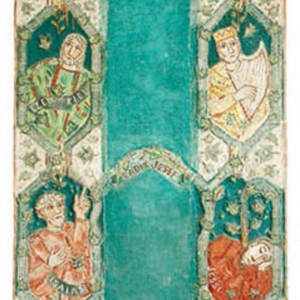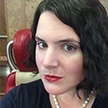 Today’s reading from Isaiah 11:1-10 references the Tree of Jesse. In these verses, the Prophet Isaiah foretells of the coming of Jesus through the lineage of his ancestors: “On that day, a shoot shall sprout from the stump of Jesse, and from his roots a bud will blossom.” If you are ever at Mass in STM’s Chapel and happen to look up into the choir loft, you will see a tapestry-like fresco-mosaic. This is our own visual depiction of Isaiah 11:1-10.
Today’s reading from Isaiah 11:1-10 references the Tree of Jesse. In these verses, the Prophet Isaiah foretells of the coming of Jesus through the lineage of his ancestors: “On that day, a shoot shall sprout from the stump of Jesse, and from his roots a bud will blossom.” If you are ever at Mass in STM’s Chapel and happen to look up into the choir loft, you will see a tapestry-like fresco-mosaic. This is our own visual depiction of Isaiah 11:1-10.
In a previous “From the Archives” article in STM Magazine, Frank Greaney ꞌ68 M.P.H. explored the theological and artistic dimensions of the Chapel’s Tree of Jesse. As a way to continue celebrating one hundred years of Catholic chaplaincy during Advent, it seemed like the perfect time to add more to the story. And by adding to the story, to not only highlight our first Chaplain’s connection to prominent New York Catholic families, but also to further tell the story of the two women who created and financed the Chapel’s fresco-mosaic.
STM’s Tree of Jesse was added to the Chapel three years after its initial building and dedication. In his report to STM’s Board of Trustees on June 30, 1941, Father T. Lawrason Riggs ꞌ10 reports that Miss Elsa Schmid “is now working on the mosaic, which Mrs. Suydam Cutting is contributing.”
Elsa Schmid was one of the few female Catholic liturgical artists in the early twentieth century. A sculptor, mosaicist, painter and stained-glass artist, she was active in the New York art world. Married to J.B. Neumann, a prominent art dealer in the day, she ran in the same art and Catholic circles as Mrs. Suydam Cutting. Mrs. Cutting was a collector of fine art. By the end of her life in 1961, her collection included works by Renoir and Van Gough.
Mrs. Cutting, the donor of the Tree of Jesse, was born Helen McMahon in New York. She was the winner of the New York Time’s Typical American Girl of Today contest in 1913—which was when she initially caught her first husband’s eye. She married James Cox Brady ꞌ04, a very wealthy Catholic financier from New York, in 1920. After Brady died in 1927, she married Charles Suydam Cutting in 1932. Cutting was a naturalist and the first Westerner allowed in Tibet. Helen accompanied Cutting on his second journey to Tibet and was the first white woman to meet the Dalai Lama. She helped Cutting write an account of these Tibetan travels, entitled The Fire Ox and Other Years (1940). Fr. Riggs invited Cutting to lecture on his Tibetan travels at STM on November 16, 1938—only a month after the Chapel was formally dedicated.
Helen knew Fr. Riggs through her first husband and her stepson—all three men were Catholic and at some point, undergraduates at Yale. Her stepson was also an active member of STM in the late 1930s. Brought up at Catholic school herself, she wanted her first husband’s memory to be beautifully illuminated and remembered at his alma mater and STM’s newly built Chapel was an excellent place to do just that. Helen also placed a beautiful, hand-illuminated manuscript in Fordham’s library in memory of her first husband.
Though STM does not have an exact date when Elsa finished the fresco-mosaic, it was probably around the end of summer the summer of 1941. On September 19, 1941, Fr. Riggs blessed the completed piece in the presence of Helen, the five stepchildren she shared with James Cox Brady and STM’s Board President.
Works Referenced
New York Times. “C. Suydam Cutting, Who Made Historic Visit to Tibet, Is Dead.” August 25, 1972.
New York Times. “James Co Brady Marries in London.” October 3, 1920
New York Times. “Mrs. C. Suydam Cutting Dead; Served on Board of Lighthouse.” July 22, 1961.
Saint Thomas More Corporation. Board Meeting Minutes, 1941.
STM Scrapbook 1936-1943.

 Sarah Woodford '10 M.Div.
Sarah Woodford '10 M.Div.


